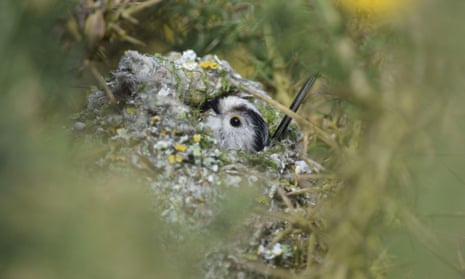There’s been an edginess to this May. Blackthorn and hawthorn blossomed side by side and drought-stunted bluebells started flowering just five centimetres above the ground. They now seem to be compensating with intensity of colour – a beyond-blue that presses on my retinas, hinting at worlds beyond the limits of my senses and understanding. Worlds seen by kestrels and by bees, smelled by badgers, heard by foxes, felt by spiders.
Among the bluebells I find a nest, dislodged from nearby brambles by a predator. It is the size and shape of a child’s deflated football, but its colours and textures are those of a forest or a world, myriad and fractal. It is made of moss, laced and bound by spider silk, then decorated with grey lichen and lined with feathers. The feathers spill from a hole in the side: their colours, shapes and sizes suggesting donations from all the birds of the wood.
I lift it cautiously in case there is anyone inside – alive or dead, nestling or scavenger – but it’s empty. Broods fledge successfully from fewer than one in five long-tailed tit nests, but there is a strong esprit de corps between these convivial little birds, and adults whose own breeding efforts fail often rejoin a brother to assist in rearing nieces and nephews.
I reach inside the nest and it stretches easily to enclose around my hand, an elastic mitt that would fit a small child or a big man. Immediately I feel my body heat accumulating and marvel at the structural, functional and aesthetic perfection of the thing, created by avian engineers weighing no more than two teaspoons of sugar.
Where did their mastery of materials come from? How did they know what to use, where to find it, how to weave and loop, where to reinforce and how to camouflage, when to stop? Perhaps partly from assisting others. Perhaps from hours studying their own nursery walls. But part of it, we have to accept, is they just know. In a human you might call it instinct, talent, a gift. But that isolates it from the omnificence that is nature’s ability to create anything. I’m holding a product of knowing that belonged not only to a tiny bird, but to the universe itself.

Comments (…)
Sign in or create your Guardian account to join the discussion